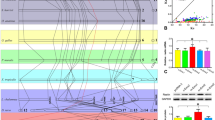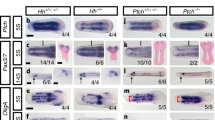Abstract
THE diencephalon is a complex integration centre and intricate relay station of the vertebrate brain1–3. Its development involves the generation of great cellular diversity and neuronal specificity. We report here that it becomes organized in steps, through a stereotyped sequence of neuromeric subdivisions. Diencephalic neuromeres define four cellular domains (D1–D4) that can be followed throughout development, each unit contributing to a well defined part of the adult structural pattern. We propose that the segmental identity of each diencephalic unit is specified by a unique combination of genes4–13, maintained by polyclonal cell lineage restrictions. A comparison of vertebrate and arthropod development suggests that the basic principles that control anterior axial patterning and set up neuronal specificity in the embryonic central nervous system are highly conserved in evolution.
This is a preview of subscription content, access via your institution
Access options
Subscribe to this journal
Receive 51 print issues and online access
$199.00 per year
only $3.90 per issue
Buy this article
- Purchase on Springer Link
- Instant access to full article PDF
Prices may be subject to local taxes which are calculated during checkout
Similar content being viewed by others
References
Ramóny Cajal, S. Studies on the Diencephalon (Thomas, Springfield, 1966).
Ariëns Kappers, C. U., Huber, G. C. & Crosby, E. C. The Comparative Anatomy of the Nervous System of Vertebrates, Including Man (Hafner, New York, 1960).
Sarnat, H. B. & Netsky, M. G. Evolution of the Nervous System (Oxford Univ. Press, Oxford, 1981).
Wilkinson, D. G., Bailes, J. A. & McMahon, A. P. Cell 50, 79–88 (1987).
Roelink, H. & Nusse, R. Genes Dev. 5, 381–388 (1991).
McGrew, L. L. Otte, A. P. & Moon, R. T. Development 115, 463–473 (1992).
Price, M. et al. Nature 351, 748–751 (1991).
Price, M. et al. Neuron 8, 241–255 (1992).
Porteus, M. H. et al. Neuron 7, 221–229 (1991).
Simeone, A. et al. Nature 358, 687–690 (1992).
Walther, C. & Gruss, P. Development 113, 1435–1449 (1991).
Krauss, S. et al. Nature 353, 267–270 (1991).
Tao, W. & Lai, E. Neurons 8, 957–966 (1992).
Kuhlenbeck, H. The Central Nervous System of Vertebrates (S. Karger, Berlin, 1973).
von Kupffer, K. in Handbuch der vergleichenden und experimentellen Entwicklungslehre der Wirbeltiere. (ed. Hertwig, O.) Bd 2, Teil 3 (Fischer, Jena, 1906).
Rendahl, H. Acta zool. 5, 119–344 (1924).
Bergquist, H. Progr. Brain Res. 5, 223–229 (1964).
Vaage, S. The Segmentation of the Primitive Neural Tube in Chick Embryos (Gallus domesticus) (Springer, Berlin, 1969).
Keyser, A. Acta anat. 83 (suppl. 59), 1–177 (1972).
Puelles, L., Amat, J. A. & Martínez-de-la-Torre, M. J. comp. Neurol. 266, 247–268 (1987).
Altman, J. & Bayer, S. A. J. comp. Neurol. 275, 346–405 (1988).
Hamburger, V. & Hamilton, L. J. Morph. 88, 49–92 (1951).
Stern, C. D., Sisodiya, S. M. & Keynes, R. J. J. Embryol. exp. Morph. 91, 209–226 (1986).
Lumsden, A. & Keynes, R. Nature 337, 424–428 (1989).
Layer, P. G. & Alber, R. Development 109, 613–624 (1990).
Cooper, N. G. F. & Steindler, D. A. J. comp. Neurol. 249, 157–169 (1986).
Bate, C. M. & Grünewald, E. B. J. Embryol. exp. Morph. 61, 317–330 (1981).
Thomas, J. B. et al. Nature 310, 203–207 (1984).
Stern, C. D. et al. Development 104 (suppl.), 231–244 (1988).
Fraser, S., Keynes, R. & Lumsden, A. Nature 344, 431–435 (1990).
Stern, C. D. & Keynes, R. J. Development 99, 261–272 (1987).
Garcéía-Bellido, A., Ripoll, P. & Morata, G. Nature New Biol. 245, 251–253 (1973).
Lawrence, P. A. Nature 344, 382–383 (1990).
McGinnis, W. & Hoxlauf, R. Cell 68, 283–302 (1992).
Cohen, S. M. & Jürgens, G. Nature 346, 482–485 (1991).
Martínez, S., Wassef, M. & Alvarado-Mallart, R. M. Neuron 6, 971–981 (1991).
Yamada, T. et al. Cell 64, 635–648 (1991).
Author information
Authors and Affiliations
Rights and permissions
About this article
Cite this article
Figdor, M., Stern, C. Segmental organization of embryonic diencephalon. Nature 363, 630–634 (1993). https://doi.org/10.1038/363630a0
Received:
Accepted:
Issue Date:
DOI: https://doi.org/10.1038/363630a0
This article is cited by
-
In Xenopus ependymal cilia drive embryonic CSF circulation and brain development independently of cardiac pulsatile forces
Fluids and Barriers of the CNS (2020)
-
Redundant type II cadherins define neuroepithelial cell states for cytoarchitectonic robustness
Communications Biology (2020)
-
Recurrent DCC gene losses during bird evolution
Scientific Reports (2017)
-
Barhl2 Determines the Early Patterning of the Diencephalon by Regulating Shh
Molecular Neurobiology (2017)
-
Cell migration in the developing rodent olfactory system
Cellular and Molecular Life Sciences (2016)
Comments
By submitting a comment you agree to abide by our Terms and Community Guidelines. If you find something abusive or that does not comply with our terms or guidelines please flag it as inappropriate.



